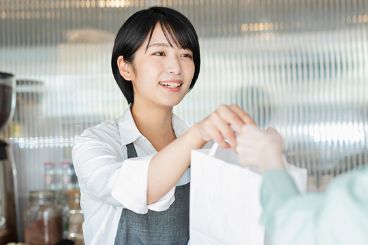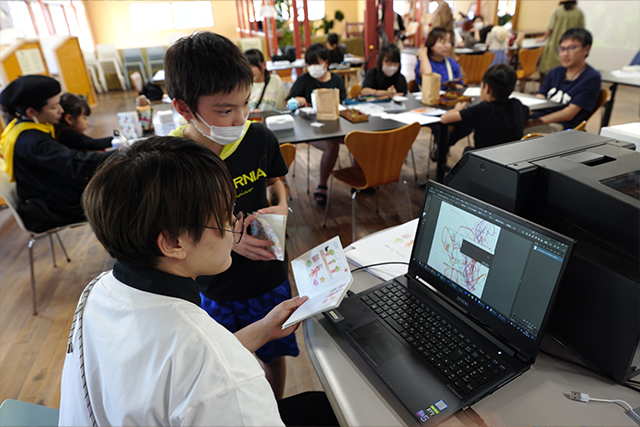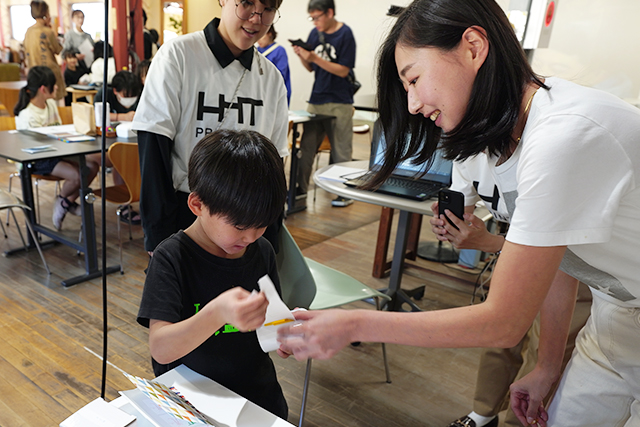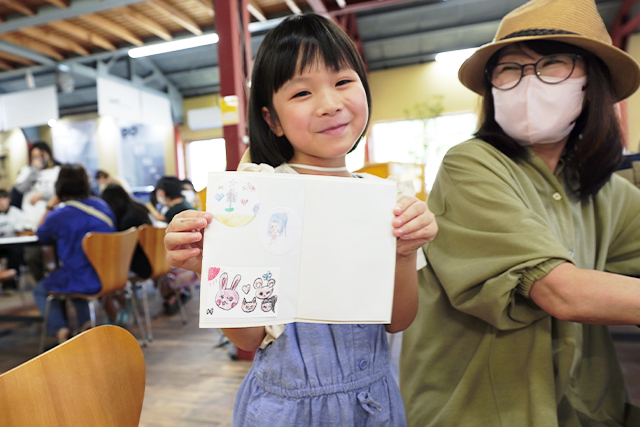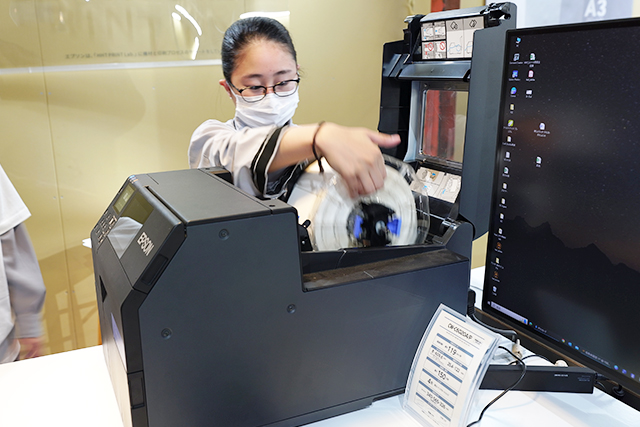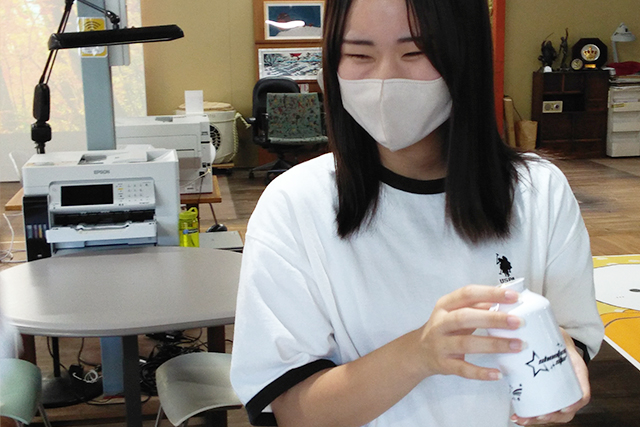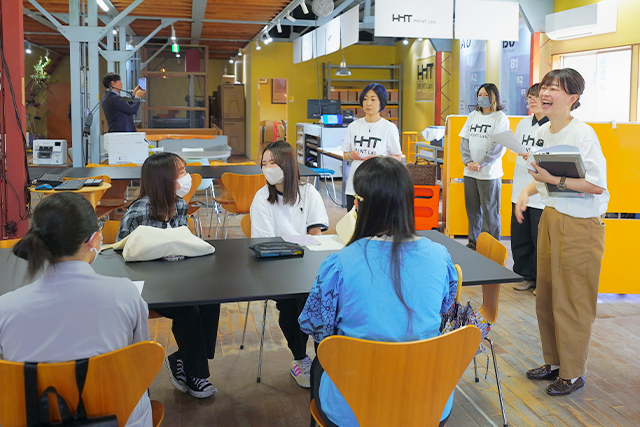Let's tackle social challenges through innovation with Epson!
Epson in Community Cocreation Project at Newly-Opened Sekibikodo HHT PRINT Lab
- Epson is involved in a cocreation program with Sekibikodo to better address issues in the Aizuwakamatsu community.
- HHT PRINT Lab is a community facility that business operators, creators, students, and others in the Aizu region can use to easily process short print jobs.
- Local school children and college students attended hands-on workshops about the printing and production of original content. In this article, we report on these events.
HHT PRINT Lab. is a creative production space run by Sekibikodo with technical support from Epson. It is outfitted with the latest Epson printers and services. The space is equipped with commercial printers that can print on labels, T-shirts, posters, bottles, and a variety of other media. It was created to give people in the community─everyone from Aizu business operators to creators and students─a convenient printing experience. With the support of the staff, even those who are not used to making things or who are new to printing can comfortably enjoy the creative process using digital printing.
In this article, we explain the purpose of the HHT PRINT Lab., describe the workshops, and share comments from participants and staff members.
■Erika Koshiba (left)
Sekibikodo, Aizuwakamatsu City
■Ryoko Tamaki (right)
P Strategic Planning Department, Seiko Epson Corporation

Aims of this community co-creation project and the HHT PRINT Lab

The need to print short jobs with low page counts has grown in recent years, accelerated by a drive to promote the industrialization of agriculture in rural areas and the resumption of events post-pandemic. However, people with no knowledge of data production and printing faced challenges and needed someplace to go to ask for advice.
This provided the impetus to establish the HHT PRINT Lab in Sekibikodo's Human Hub Tenneiji Soko, a facility in a former warehouse that attracts local business operators, creators, and others from Aizu and the surrounding region. In addition to meeting the printing needs of these people, the HHT PRINT Lab. is intended to help revitalize the local community and provide support for creative endeavors. It is a place where creators, business operators, and others who run small retail stores or host community events can go to print what they want, in the quantities they need. For example, a local sake brewery might want to print labels for a limited run of 20 bottles or festival organizers might want to print a small number of posters for the event. Another attraction of the lab is immediacy: You can see the finished prints on the spot.
In the month since it opened, the HHT PRINT Lab. has received a range of inquiries from people who want to do things such as print a photo of their pet cat on a tote bag, make wrapping paper for their products, or print T-shirts for their child's school club.


HHT PRINT Lab. Workshop

The HHT PRINT Lab. first created a workshop where children in the community can get a taste of how fun it can be to create and produce your own things. At the workshop they produced original stickers and hiking water bottles. Epson provided support for the printing process.
The children drew pictures with crayons and colored pencils that the staff then scanned and printed. They watched with interest as their drawings were printed out and appeared to be delighted with the results.
The children's happy voices echoed through the first floor. Some even came up to the second floor to see what was going on.




On the day of the workshop, we also produced original sticker books using Epson design paper and presented them to the children. After choosing their favorite book, the children proudly showed their parents and staff members the stickers they made and stuck them all over the pages. The parents were surprised to see their children's creativity and artistic sense. The workshop created special memories for them and their children, and the drawings on stickers and water bottles made good keepsakes. Workshop participants talked about how happy they were to see the excitement demonstrated by their children. Families had fun together and were able to preserve the children's drawings both physically and as memories.
Commercial printing experience for college students

A hands-on production workshop was held for students of Aizu Junior College. It gave them the opportunity to use the printers to produce original works.
The students were divided into groups to practice three types of printing: sticker printing, large format printing, and dye-sublimation transfers on water bottles. The students, who are studying design, brought their own design data with them.


The students showed interest in the water bottles and stickers, items that normally would have to be produced by a commercial printing company. Dye-sublimation transfer technology was used to print on the water bottles. A design is printed on transfer paper with dye-sublimation ink. Heat is applied to the paper to vaporize the ink, which is then absorbed into the polyester or other materials. Dye-sublimation transfer printing is well-suited to short-run print jobs for things such as personal items and giveaways.




Taki, who enjoys making items from a friend's illustrations, has used an online printing service several times, but said that it takes two weeks from the time of order to delivery. Only then can the output be checked. Taki appreciates that the HHT PRINT Lab. allows him to check the finished product on the spot. He said he'd like to come back again the next day and use the printer. The students who participated in the workshop had a lot of ideas for using the HHT PRINT Lab. They talked about wanting to make things like T-shirts with pictures of their cats or making water bottles as birthday presents for their friends.
Interview with Sekibikodo staff member Erika Koshiba
After the children's workshop, we interviewed Erika Koshiba, a member of the HHT PRINT Lab. staff. We asked her about running the workshop and about future developments.

── How was the workshop?
This was our first workshop for children, many of whom have had very few opportunities to participate in events of any kind because of the pandemic. I think it was a great way for parents and children to make memories together. The parents seemed satisfied to watch their children enjoy themselves. After the children finished printing their stickers, some of the parents even asked if we wouldn't mind printing out another sheet that they could have as a keepsake.
── Did the workshop give you a better understanding of printer operation and the printing process?
I learned that anyone on the staff can follow these simple steps to print. Dye-sublimation transfer printing on water bottles, for example, seems like it would be difficult and time-consuming, but the process is surprisingly simple, and stickers are simply printed after data is read. Anyone can quickly and easily learn to do it with a little practice. Once they experience the whole process, anyone on the HHT PRINT Lab. staff can produce prints.
── Are there any ideas that you would like to try in the future?
We are considering creating packages for tourists who stop by the store. The package would contain stickers with photos from their trip to Aizu. We would also like to hold a road event called the Snow Monozukuri Marche and print stickers for children who visit on field trips. November 3 is the first anniversary of the Human Hub Tenneiji Soko, and we are planning another event to print original items on the spot for that occasion. Running this workshop gave us a better idea for future steps and events. I had no idea that a print workshop could be so much fun to run. I look forward to holding a variety of fun and exciting events.

Sekibikodo's Human Hub Tenneiji soko
In November 2022, Sekibikodo, a lacquerware business in Aizuwakamatsu, Fukushima Prefecture, renovated its former Head Office and plant in Tenneiji-cho, turning it into the Human Hub Tenneiji Soko.
It is intended to be a "human hub," a place where people involved in production and creative endeavors can meet and inspire each other, a place where the traditional local lacquerware industry converges with leading digital technology for smart cities.
965-0877
6-30 Nishisakae Machi, Aizuwakamatsu City, Fukushima Prefecture
This article is from September 2023.
Note: All information on organization names, affiliations, titles, and interview content were correct as of the time of the interview.

